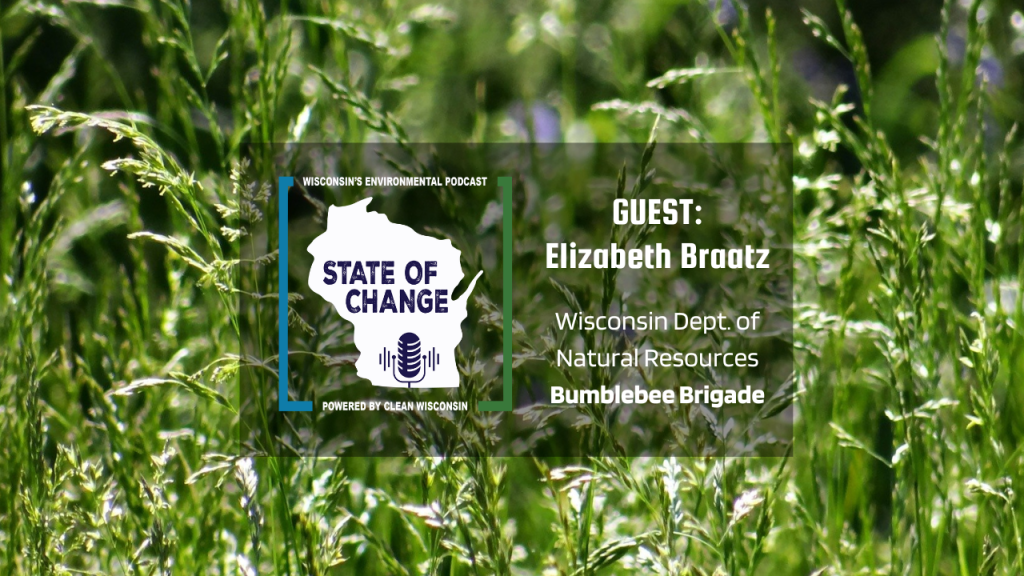No Mow May is here, but does it really make a difference in the battle to save our bees and butterflies? Amy walks through a typical Wisconsin yard with pollinator expert Elizabeth Braatz.
Host:
Amy Barrilleaux
Guest:
Elizabeth Braatz, Bumble Bee Brigade Coordinator and Terrestrial Insect Ecologist, Wisconsin Department of Natural Resources
Background Reading:
Saving Wisconsin’s Native Pollinators
Corn Ethanol vs. Solar: A Land Use Comparison
Where to Listen:
Transcript:
Amy It’s that time of year when we have a decision to make, to mow or not to mow? Since it started in the UK, No Mow May has reached Wisconsin, and that means dandelions and violets left untouched in yards across the state. But does it really make a difference in the battle to save our pollinators? I’ll take a look. I’m Amy Barrilleaux, and this is State of Change from Clean Wisconsin.
On a warm early spring day, I meet Elizabeth Braatz, who heads up the Bumblebee Brigade pollinator program for the Department of Natural Resources, to tour a typical Wisconsin yard and learn all about No Mow May. Full disclosure: it’s my yard. First, I guess explain. For people who haven’t heard of No Mow May what the general concept is around that?
Elizabeth So the kind of the concept of No Mow May started, with people thinking that, well, what if we don’t mow for a month so that little flowers in the midst of a yard have a chance to, grow up a little further and, well, there’s a lot of research that still needs to be done on that. Specifically not mowing at all for the month of May. There has been, there’s research done on bee friendly lawns, which is the idea that, if you have spring ephemeral or small little flowers that are poking up throughout your lawn, it can be really helpful for native bees and other pollinators. And similarly, maybe, kind of Less Mow May or Slow Mow Summer might be the, the way to pivot because it can be, very neat in, in theory and then kind of hard in practice to not mow for a month and then have a very large lawn with annoyed neighbors. And, and it actually can be very hard on the grass. So another way to look at it is just to kind of slow mo summer where you let it grow higher than you normally might, would maybe at the highest setting that your lawn mower can do, and then try to mow about one third of the amount. Rather than going from maybe like 12in to 3in or something, so after the end of the month and everyone’s sick of it. Like, all right, let’s just cut it all short again. But there’s, there’s a lot of other ways as well. So, just standing in your yard, I’m seeing all sorts of examples of ways that, you know, it’s can, can provide really, really crucial habitat.
Amy Well, let’s take a look. So I don’t have very many flowering weeds yet, but we’ll walk in the back because I have a couple, you know, it takes a while for my yard to start growing anything. So I guess, with No Mow May, people are thinking, well, these little spring flowers are popping out, and that’s where, you know, that’s what the pollinators need. Is that basically true?
Elizabeth Yes. Spring blooming flowers are really, really vital for pollinators. For example. So we’re going to think about the life cycle of the bumble bee. So we, we live year after year and we eat throughout the winter and everything. But bumblebees don’t quite do that. They have an annual cycle. So that means that, while we’re, cozy at our homes, they’re cozy under the, under leaf litter and so on, which is a great reason why having leaving a bit of leaves in your yard can be really, really valuable for these overwintering insects. Most of the colony, is dead during winter. Only the the new queens or gynes are alive and they are overwintering. But after they wake up in the spring, they are very hungry. And so they need two things. They need to search for a, place to nest for the future colony. And they need to feed themselves because they have had a very, very long, diet over the winter. And, and also, they need enough food to provision their new colony. So that’s why spring blooming plants are an early blooming flowers are actually really key because while we may not see as many bees, the ones that we do see are really important because they are off in the Queens. So if you. Yeah.
Amy So if we see, bees this time of year, that’s queens that have just now kind of come out of their underground or under leaf, overwintering stay.
Elizabeth Yeah, yeah. It’s very, very likely that most of the bees you see in early spring are going to be queens or gynes. I mean, maybe if I want to get to get out really, really early, then maybe she’s already made a generation, but that would be unlikely. Most of the time. It’s, it’s kind of a new queens, and you can tell them, besides the timing of it, they tend to be a little larger than, workers of the same species. They tend to be very well groomed at the moment, for lack of a better word. Very, very tidy bees with very nice hair. And especially if you see them scanning, kind of zigzagging along the ground. It’s it’s like they’re searching for something and they are they’re they’re probably searching for a nest site.
Amy [Well, so over here in the back, I have these little blue flowers, also looking very weedy. So we certainly haven’t mowed yet. So these are, maybe something that pollinators might want to, dig into.
Elizabeth Yeah. Quite possibly. And, I it’s it’s interesting the, the kind of the, the weedy concept is, is something that, it would be it’s, it would be great to have discussions on and maybe kind of start shifting that mindset of, so why do we think that this perfect English lawn from across the sea is is what everything needs to to look like. And and it’s okay to have a bit of, weed of native plants and natural, spring blooming flowers and things like that. And if you, I know that some people are in HOA fees and similar things, and they have to be careful. So I don’t I’m not saying to, to, to flout all the rules, but sometimes also you can have kind of gradient of neatness. Maybe the front yard is more neat. And then you have, you can, you can do a bit of your own thing a little more in the backyard. But I think it’s very, very possible to have a very, very beautiful yard and, provide a ton of habitat for native bees.
Amy So if we look here at, we’re in my, not very well-kept backyard with plenty of random stuff around,.
Elizabeth Beautiful backyard!
Amy Yeah. (laughs) It’s uh, lovely. So looking back, so this is a part of a dead part of a tree that we had trimmed last when we trimmed and we didn’t know what to do with the the trimmings. And so they’re just kind of piled up by the fence. We got some sort of random sticks, some, weedy flowering plants, a lot of sticks and leaves. And what I think people might come back here and be like, you need to clean all this stuff up. Should we clean it all up or what? From your pollinator perspective, what is this? What are you seeing here?
Elizabeth Seeing so much habitat! I’m seeing a lot of habitat here. And so, so we’ll we’ll go through some of the things. So there’s, some dead branches with leaves on them in the, in the back, in the corner. That is great habitat for all sorts of insects to, hide underneath and use for habitat because it provides shelter. And so we think of the kind of basics of, of, what do we need? We need food, water and shelter. And most animals are exactly the same. So, when I see that, I see that those branches and leaves and so on, I’m seeing a an insect Paradise to hide underneath and survive the winter, as well as even during later in the summer, to provide habitat for them. Similarly, we I’m seeing a pile of kind of stems. I’m going to actually wander over here. I’ll ask, look uh, pithy, see here? It’s pithy, pithy stems! So we have a ton of. So there are about 400 to 500 species of native bees in Wisconsin. Incredible diversity. All these amazing creatures just kind of flying under, under our noses. And a lot of them. So 85% of them are actually solitary. So by solitary, I mean, if you think of the kind of classic bee on the cereal box, the honeybee, these huge colonies of bees, most bees actually aren’t like that. Most of them are, kind of a single, single family businesses, mom and pop shops where the male and the female will mate, and then they’ll provide, nests and provisions for their kids. And that’s the extent of the colony. So it’s just one family. And so a lot of these bees will nest in – oh my gosh ducks! Delightful!
Amy Nature!
Elizabeth All sorts of, yeah, if anyone tuning in also likes birds, a lot of, a lot of the things that are good for pollinators are also good for birds, like, like, the, some of the flowering shrubs and so on can be great habitat, but, all right. Stems! So what what they’ll do is they will go into the, hollow, pithy stem and they’ll lay an egg, and then they’ll put in a little bit of pile of pollen ball and provisioning for the, for the little baby bee inside that stem. And then they will kind of suction it off and then they’ll lay another one with another pollen ball. They’ll keep going until there’s a whole hotel of little bees hiding inside the stem, waiting to – the dead stem, waiting to emerge in the spring. And so keeping these around is really helpful because we don’t know, this could be quite, a, quite a number of little, pollinators hiding inside, using it as a, as a home.
Amy So these are stems I think I broke off of some perennial plants in the late fall and just kind of threw them in the backyard. And so you’re saying that little bees, could be eggs, could be inside of these stems?
Elizabeth Yeah. Yeah, they’d probably be, I guess it depends on the species of, what stage they’re in at what time. But yes, they can. They’ll use woody stems and pithy stems to, to overwinter and store their, their future generations. And so you can also have kind of, of neatness it there, there are different ways that you can still have a lot of these aspects of a, pollinator friendly habitat and still have it look very neat and orderly. For example, the University of Wisconsin Arboretum is wonderful habitat. And it’s also – well, they also have people who are working very, very diligently as their full time jobs to to keep a tidy – but but it is also very tidy. For example, for the stems, you can I’ve seen people kind of pile them and put them in the back. Similarly for leaf mulch, you could almost use fallen leaves as mulch if you. So leaving the leaves is another really helpful thing, so that these critters can have somewhere to underneath to hibernate, which I see leaves and all sorts of things, floating around here, which is great. But people can if it’s in other parts of the yard sometimes. Maybe you want to make it off of parts of the yard, but you can use it as a free natural mulch, around your native plant gardens and so on. Similarly, some of the, the brush piles I’ve seen people make, kind of they’ll like, cut them in about the same size and then stack them in a corner so that it looks a little more like it was it was, deliberately put there and tidy and so on. Rock piles are another thing that, oh, which I see some over there!
Amy We have a giant rock piles everywhere. I think, you know, as we put in gardens, we find rocks, and then we just stick them somewhere until we might need a rock someday. So. Yeah. Big pile of rocks right here.
Elizabeth Oh, yeah. So a lot of these actually are also, ground nesting bees. And so they’ll, so little patches of bear ground or rock piles or things like that, they’ll hide underneath and use as habitat. And so you can, you can make the rock pile as, as natural or as orderly as you want. It’s still a rock pile that they can use. So.
Amy Okay!
Elizabeth Yeah. Another another great way.
Amy So this time of year, I’ll take you back to my, right now, pretty sad perennial bed in the in the back this time of year, I think I see a lot of people coming in clearing these beds out. So there are leaves that have fallen here from last fall, that right now are still there. So would you advise trying to leave these leaves because you mentioned leave the leaves or, when is the best time to clear these things out?
Elizabeth Well, if you if you can, if you can stand it, I would, I would say to let it let it stay here and provide. You’re taking away all this natural, free mulch with, all the nutrients and all the protection of the soil and all the little could invertebrates hiding underneath that might help the health of your soil underneath. And, that all these leaves are, are a part of protecting it also with, evaporation and, evaporation and moisture retention. Leaves are really, really great. So, if, if possible, I would I would encourage people to consider leaving the leaves as long as they can. And once, once the flowers and plants grow up, it’s going to be a lot harder to to see it. And anyway, so kind of just rethinking what, what what is a successful garden.
Amy So when you see people, you know, coming out on a nice spring day and, and raking out all these leaves and then replacing the leaves with mulch that they bought at the store, kind of what goes through your mind?
Elizabeth 100 tiny bees are screaming! No, no, no, no. Yeah, I totally get it. Like, we want to have things tidy. We want. And it’s become such a cultural norm as well to have. Oh well, at this time I clean everything out and I put it in the wood mulch, and then I buy more. And then I put and it’s all dyed and treated and so on, and I’ll stick this on top and it’s yeah, I, I completely understand I if, if possible using leaves as mulch instead or at least kind of reducing the mulching use is really helpful because I mentioned earlier those ground nesting bees, with a really thick mulch layer, they can’t get to the ground, so it gets really hard for them to nest. So you’re disrupting that part of their cycle. And, yeah, you can you can save a little, a little money and effort to, to let the existing cycle that’s kind of come, come about over thousands and thousands of years to, to do its course. And I would recommend that if possible. Another thing I’ve really neat thing I’ve seen with mulch in a native garden, is that you can kind of do a reverse mulch. So instead of mulching everything and leaving a path of grass that you have to keep mowing, you can mulch a path and then have gardens surrounding it. And then you walk on the mulch path and, and see your garden and have maybe a section that you leave as, as lawn to have picnics and so on.
Amy So, back to the lawn. I know you’re talking about earlier about, No Mow May and maybe it’s, it’s maybe more of a Less Mow May concept could be successful too.
Elizabeth Yeah, I definitely think so. I think, there was – University of Minnesota has been doing a lot of really great research concerning lawns, and they’ve been finding some, good, flower visiting insect responses from bee friendly lawn. So ones that such as your yard that have all these little, little flowers, interspersed in them as well as, again, maybe letting letting it grow a little higher can, can help with those, those plants growing up. But it doesn’t have to be after a full month. And, we also we want to make sure it’s sustainable from a human standpoint because, I’ve, I’ve heard that sometimes it can be hard on maintenance and the people who are, mowing or if you’re doing in a city, it can become, a bit of a bit a bit hard to maintain from a, operations standpoint. And so I, we really want to make sure these systems still work with, with what we’re doing as, as people so that we can keep doing them. Kind of like kind of like doing a, a diet where you only eat only eat broccoli for a month is probably not going to be sustainable. So I’d much rather recommend something that people can do a little bit at a time and, and not have some of the, the downsides of not mowing for too long that can sometimes arise.
Amy So I guess you’re saying, you know, if we keep some habitat, on the ground, some sticks, some leaves, rocks, that when the queens kind of come out of their nest and they’re hungry, if we haven’t mowed at this point in the year, or maybe as these natural flowers start kind of cropping up in April and May, then we’ve left some food. And that’s basically it. That’s what we really want to accomplish this time of year.
Elizabeth Exactly. Yes, exactly. We’re really looking to provide that, that for those – food for the hungry queens, or gynes, I guess if they’re bumblebees. And one, one, thing I’d also mention is to we don’t I wouldn’t get too, too worried about the exact mowing cycles, since also, if a lawn is completely covered in pesticides and insecticides and only turf grass, regardless of whether or not you mow it for a month, it probably will not be providing very much habitat for, things that are looking to, to eat from, from there. And so, that more kind of that holistic approach of what is the whole garden doing and how is it, providing habitat for those different life stages is, I think, a great, a great lens to look at it.
Amy So maybe, you know, if we look over here, I can see some more. I don’t know, I think these might be different purple flowers and then some dandelions and some other things. Once those are kind of done blooming and our grass is getting high. Maybe it’s mid-May. We shouldn’t feel too bad about going ahead and mowing the parts of our yard that are for mowing, but we should think about all the other parts of the yard.
Elizabeth Exactly. Yeah. Just. Yeah, it, you know, when it’s when it’s time to mow, sometimes you gotta mow, and I, I completely understand that. But. Yeah. So, like, like you said, thinking about those other parts of the yard, thinking about the, the piles of leaves and the native plant garden that you put in and the rock piles and all those other things. And I see that we’re actually standing right behind a vegetable garden garden. So we’re you’re getting some food. I see your tomato, trellis. Wonderful. Bumblebees are actually a really, really great pollinators of tomatoes because they’ll do buzz pollination where they basically they grab on to the flower and then they heat, and then it shakes pollen onto them. And they’re very efficient at, a lot of these plants. So. Yeah. so you’re, you’re eating, the the bees are helping with the things you’re eating as well. And, yeah, I see all these twigs and and leaves and stuff in this vegetable bed, and it’s it’s great to see.
Amy So really, the things that you might feel bad about, if you live in a suburban area, you know, not I haven’t had time to clean out my leaves. I haven’t had time to pick up all the sticks or to move my brush to the curb for brush pickup, are actually things to kind of be proud of.
Elizabeth Yeah. Take all that energy that you’re you’re spending feeling ashamed and, and trying to to try and trying to work on this. And if you, if you take a portion of that energy and turn it into, providing more of a spring blooming, summer blooming, fall blooming flowering plants and, for, for pollinators, I think you’d still end up with a really, really beautiful garden. And you’re helping encourage cycles that will help it kind of sustain itself. Yeah. So I, I guess the main takeaway is I’d, I’d say, for, for think things that you can do and no worries, you don’t have to do all of them. Like. Start. Start small with something that’s feels like you can do it this summer. Okay. And and if you if you add one of these list items every summer for the next, couple years, suddenly you’ll, you’ll look out and you’ll have this, this whole habitat. So the four kind of main items I’d say would be habitat, especially overwintering habitat. So that includes leaving the leaves, reducing mulching or maybe reversing mulching into paths and saving stems. Food. All right, so we’re providing a habitat shelter slash shelter. Now we’re looking at food. And so that’s going to be planting native blooming flowers. And and your vegetable gardens as well are great for all seasons. And and maybe that includes depending on what your whether your lawn does have those, little flowers throughout it, doing some kind of slow mo, version of mowing. Another one is also just kind of reducing pesticides and insecticides since, you can have all these sorts of things, but if you keep filling it with insecticides, well, that may kill some insects you don’t like. It will also kill a lot of insects that, are doing all sorts of work for your garden, that you may not even be realizing that they’re doing, such as eating pests naturally pollinating. And then finally, sharing knowledge. So, chit chatting, chatting about this, this new version of your garden with neighbors, chatting about with your family. Sometimes if you see, a neat bumblebee in your yard, you can send it in to the Bumblebee Brigade with the Wisconsin Department of Natural Resources. And so, yeah, try something and spread it on.
Amy Well, you know, you have made me feel so good about my yard. I I’ll just leave it like this, for as long as possible. It’s real easy to not come out and do yard work on pretty day, go for a bike ride or do something else. So, Elizabeth Braatz from the Bumblebee Brigade with the DNR. Thank you so much for coming to my yard and for sharing your wisdom about how to protect our pollinators.
Elizabeth Well. My pleasure. Thanks for having me.
Amy All right. To learn more about what you can do to protect Wisconsin’s critical pollinators, log on to our website. Cleanwisconsin.org. I’m Amy Barrilleaux, and you’ve been listening to State of Change powered by Clean Wisconsin.






